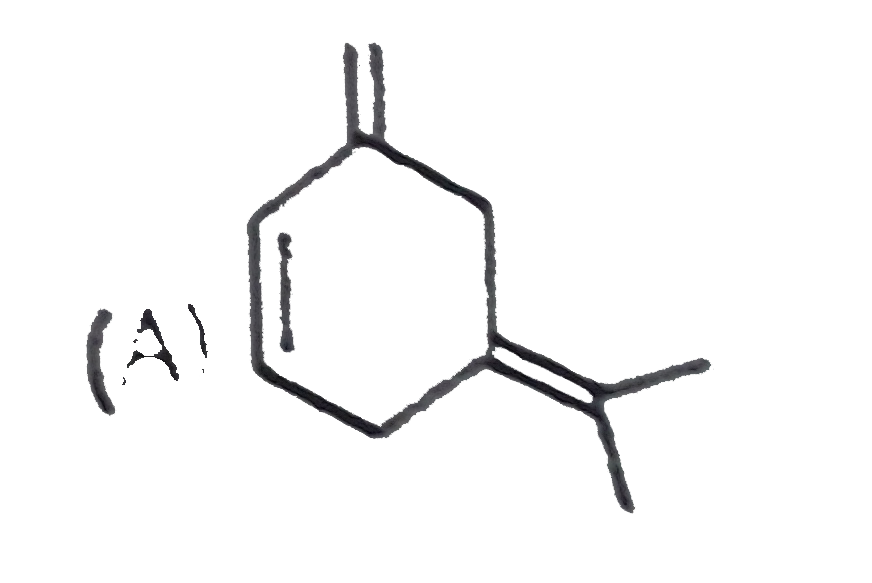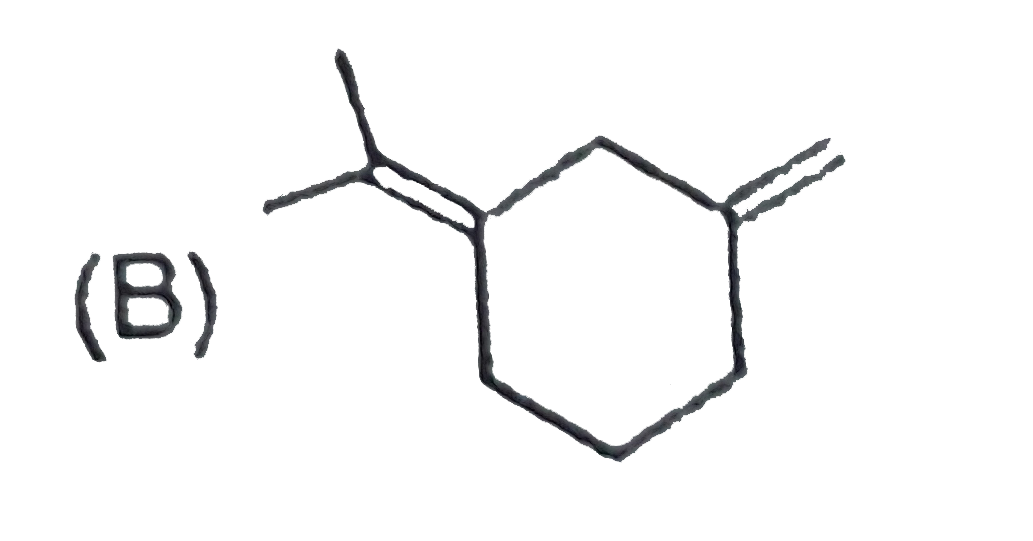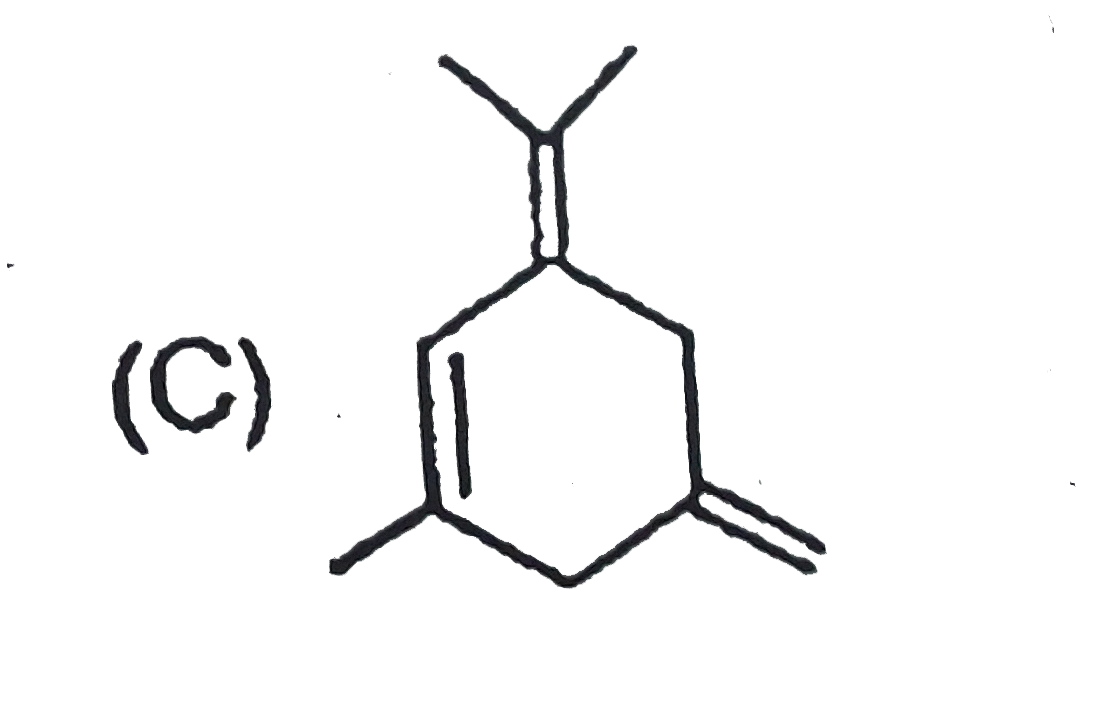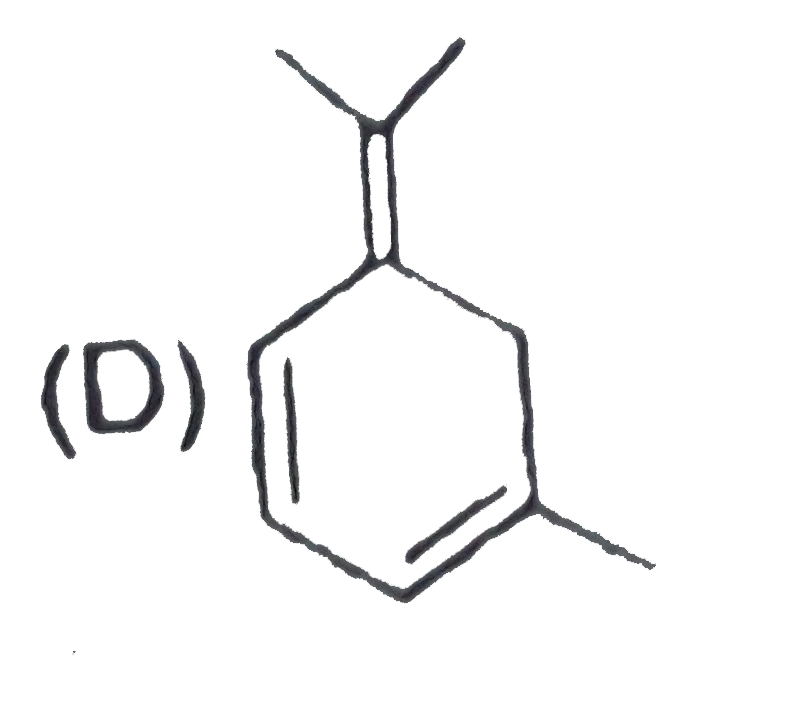An unsaturated hydrocarbon on complete hydrogenation gives 1-isopropl-3-methylcyclohexane, after ozonolysis it gives one mole of formaldehyde, one mole of acetone and one mole of 2,4-Dixoxohexanedial.The possible structure of the hydrocarbon may be




The correct Answer is:A
To determine the possible structure of the unsaturated hydrocarbon based on the given information, we will follow these steps:
Step 1: Analyze the Products of Ozonolysis
The unsaturated hydrocarbon yields:
- 1 mole of formaldehyde (HCHO)
- 1 mole of acetone (CH₃COCH₃)
- 1 mole of 2,4-dioxohexanedial
Structures:
- Formaldehyde: HCHO (a carbonyl group with two hydrogens)
- Acetone: (CH₃)₂CO (a carbonyl group with two methyl groups)
- 2,4-Dioxohexanedial: This compound has two carbonyl groups (C=O) at positions 2 and 4, and two aldehyde groups (C=O) at the ends.
Step 2: Determine the Structure of 2,4-Dioxohexanedial
The structure of 2,4-dioxohexanedial can be drawn as follows:
- It has a six-carbon chain (hexane).
- The carbonyl groups are at the 2nd and 4th positions.
- The two ends are aldehyde groups.
The structure can be represented as:
O=CH−CH=O∣C=O
This indicates that there are two carbonyl groups in the middle of the chain.
Step 3: Consider the Ozonolysis Reaction
During ozonolysis, the double bonds in the unsaturated hydrocarbon are cleaved, resulting in the formation of the carbonyl compounds. The presence of formaldehyde and acetone suggests that the original hydrocarbon must have had a structure that could yield these products upon cleavage.
Step 4: Identify the Unsaturated Hydrocarbon
Given that the hydrogenation of the unsaturated hydrocarbon yields 1-isopropyl-3-methylcyclohexane, we can deduce that the original hydrocarbon must have a structure that, when hydrogenated, results in this cyclic compound.
Step 5: Construct the Possible Structure
To satisfy both the ozonolysis products and the hydrogenation product, we can propose a structure for the unsaturated hydrocarbon. The likely structure is:
CH3∣CH3−CH−CH=CH−CH2−CH3
This structure has:
- A double bond that can be cleaved to give formaldehyde and acetone.
- The ability to hydrogenate to form 1-isopropyl-3-methylcyclohexane.
Conclusion
The possible structure of the unsaturated hydrocarbon is:
CH3∣CH3−CH−CH=CH−CH2−CH3
The unsaturated hydrocarbon yields:
- 1 mole of formaldehyde (HCHO)
- 1 mole of acetone (CH₃COCH₃)
- 1 mole of 2,4-dioxohexanedial
- Formaldehyde: HCHO (a carbonyl group with two hydrogens)
- Acetone: (CH₃)₂CO (a carbonyl group with two methyl groups)
- 2,4-Dioxohexanedial: This compound has two carbonyl groups (C=O) at positions 2 and 4, and two aldehyde groups (C=O) at the ends.
The structure of 2,4-dioxohexanedial can be drawn as follows:
- It has a six-carbon chain (hexane).
- The carbonyl groups are at the 2nd and 4th positions.
- The two ends are aldehyde groups.
O=CH−CH=O∣C=O
This indicates that there are two carbonyl groups in the middle of the chain.
During ozonolysis, the double bonds in the unsaturated hydrocarbon are cleaved, resulting in the formation of the carbonyl compounds. The presence of formaldehyde and acetone suggests that the original hydrocarbon must have had a structure that could yield these products upon cleavage.
Given that the hydrogenation of the unsaturated hydrocarbon yields 1-isopropyl-3-methylcyclohexane, we can deduce that the original hydrocarbon must have a structure that, when hydrogenated, results in this cyclic compound.
To satisfy both the ozonolysis products and the hydrogenation product, we can propose a structure for the unsaturated hydrocarbon. The likely structure is:
CH3∣CH3−CH−CH=CH−CH2−CH3
This structure has:
- A double bond that can be cleaved to give formaldehyde and acetone.
- The ability to hydrogenate to form 1-isopropyl-3-methylcyclohexane.
The possible structure of the unsaturated hydrocarbon is:
CH3∣CH3−CH−CH=CH−CH2−CH3
Topper's Solved these Questions
Similar Questions
Farnesence is a compound found in the waxy coating of apples. On hydrogenation it gives 2,6,10-Trimethyl dodecane. On ozonolysis it gives one mole acetone, one mole of formoaldehyde, one mole of 2-Methylpentanedial and one mole of 4-Oxopentanal. The structure proposed for Farnesence may be
View SolutionLinear polyenes on ozonolysis gives two moles of acetaldehyde and one mole of propanedinal. Linear polyene will be
View Solution
Knowledge Check
On combustion, one mole of a hydrocarbon gives 2 moles of carbon dioxide and two moles of water and a large quantity of heat is produced. The hydrocarbon is
AmethaneBethaneCetheneDethyneOne mole of a hydrocarbon on ozonolysis yirlds one mole of glyoxal and two moles of formaldehyde. The hydrocarbon is :
ACH2=C∣CH3−C∣CH3=CH2BCH2=CH−CH=CH2CCH2CH−CH2−CH=CH2DCH3CH=C=CH2
One mole of alkene an ozonolysis gives two moles of butanone. The alkene is :
View SolutionGive chemical equation for the reaction of one mole of ethene with one mole of chlorine gas.
View SolutionOne mole of a symmetrical alkene on ozonolysis gives two moles of
an aldehyde having a molecular mass of 30u. The alkene is:
View SolutionOne mole of a symmetrical alkene on ozonolysis gives two moles of an aldehyde having a molecular mass of 44u. The alkene is:
View SolutionAn organic compound (P) on reductive ozonolysis gives one mole each of acetaldehyde, formaldehyde and carbon dioxide, the compound can be
View SolutionA diene on reductive ozonolysis produces two moles of ethanal and one mole of propan -1,3-dial How many geometrical isomer (s) is/are possible for the diene?
View Solution
